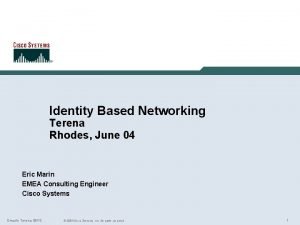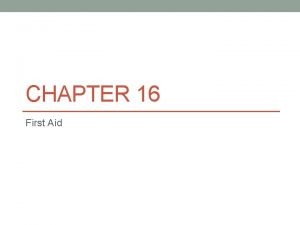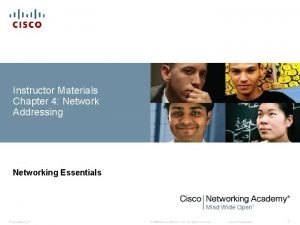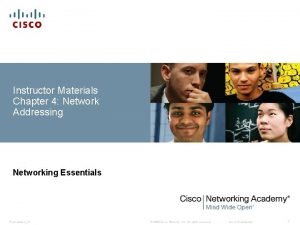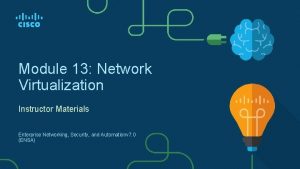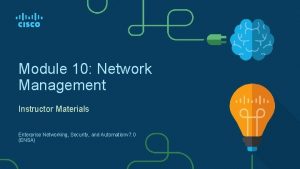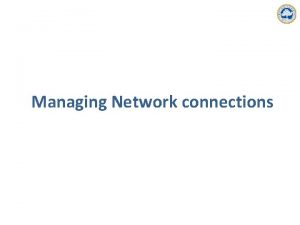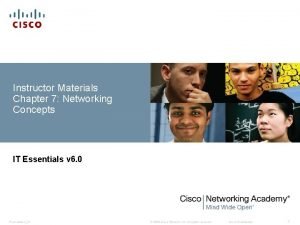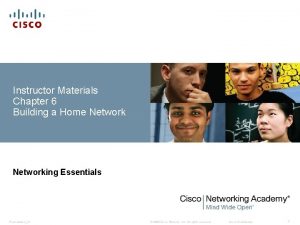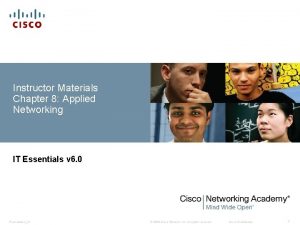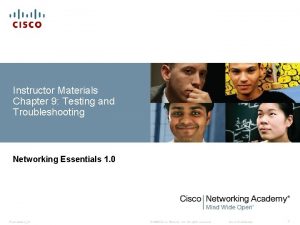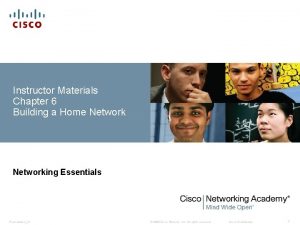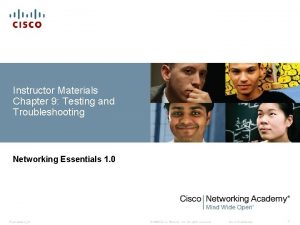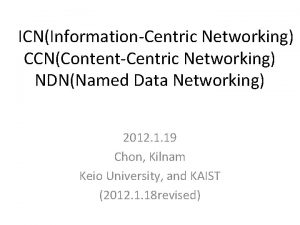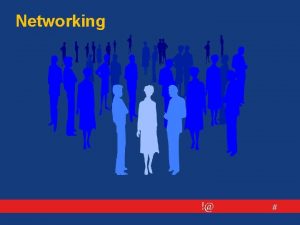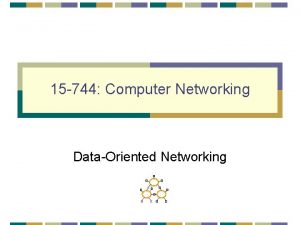Instructor Materials Chapter 5 Providing Network Services Networking


















- Slides: 18

Instructor Materials Chapter 5 Providing Network Services Networking Essentials Presentation_ID © 2008 Cisco Systems, Inc. All rights reserved. Cisco Confidential 1

Chapter 5: Providing Network Services Networking Essentials Presentation_ID © 2008 Cisco Systems, Inc. All rights reserved. Cisco Confidential 8

Chapter 5 - Sections & Objectives § 5. 1 How Clients and Servers Work Together • • Explain how clients access Internet services. § 5. 2 Internet Protocols at Work • Explain how the protocols of the transport layer support network communications. § 5. 3 Application Protocols and Services • Explain the function of common Internet client/server applications. Presentation_ID © 2008 Cisco Systems, Inc. All rights reserved. Cisco Confidential 9

5. 1 How Clients and Servers Work Together Presentation_ID © 2008 Cisco Systems, Inc. All rights reserved. Cisco Confidential 10

How Clients and Servers Work Together The Client Server Relationship § There are millions of servers connected to the Internet, providing services such as web sites, email, financial transactions, and music downloads to clients. § The primary characteristic of client/server systems is that the client sends a request to a server, and the server responds by carrying out a function, such as sending the requested document back to the client. Presentation_ID © 2008 Cisco Systems, Inc. All rights reserved. Cisco Confidential 11

How Clients and Servers Work Together The Client Server Relationship § A uniform resource locator (URL) is used to locate the server and a specific resource. The URL identifies: • • Presentation_ID Protocol being used, usually HTTP (Hypertext Transfer Protocol) for web pages Domain name of the server being accessed Location of the resource on the server Resource © 2008 Cisco Systems, Inc. All rights reserved. Cisco Confidential 12

How Clients and Servers Work Together TCP/IP Protocols for Internet Services § Some of the protocols used for Internet services are: • Domain Name System (DNS) - Resolves Internet names to IP addresses. • Secure Shell (SSH) - Used to provide remote access to servers and networking devices. • Simple Mail Transfer Protocol (SMTP) - Sends email messages and attachments from clients to servers and from servers to other email servers. • Post Office Protocol (POP) - Used by email clients to retrieve email and attachments from a remote server. • Internet Message Access Protocol (IMAP) - Used by email clients to retrieve email and attachments from a remote server. • Dynamic Host Configuration Protocol (DHCP) - Used to automatically configure devices with IP addressing and other necessary information to enable them to communicate over the Internet. • Web Server - Transfers the files that make up the web pages of the World Wide Web using Hypertext Transfer Protocol (HTTP). • File Transfer Protocol (FTP) - Used for interactive file transfer between systems. Presentation_ID © 2008 Cisco Systems, Inc. All rights reserved. Cisco Confidential 13

5. 2 Internet Protocols at Work Presentation_ID © 2008 Cisco Systems, Inc. All rights reserved. Cisco Confidential 14

Internet Protocols at Work The TCP/IP Protocol Suite § The various protocols necessary to deliver a web page function at the four different levels of the TCP/IP model are: application layer protocol, transport layer protocol, Internetwork layer protocol, and network access layer. § The two most common transport protocols are Transmission Control Protocol (TCP) and User Datagram Protocol (UDP). The IP protocol uses these transport protocols to enable hosts to communicate and transfer data. § When an application requires acknowledgment that a message is delivered, it uses TCP. § UDP is a 'best effort' delivery system that does not require acknowledgment of receipt. Presentation_ID © 2008 Cisco Systems, Inc. All rights reserved. Cisco Confidential 15

Internet Protocols at Work Keeping Track of the Conversation § A port is a numeric identifier within each segment that is used to keep track of specific conversations between a client and server. § Ports are categorized into three groups: Well-known, registered, and private. § Every message that a host sends contains both a source and destination port. § The source port number is dynamically generated by the sending device to identify a conversation between two devices. § The client places a destination port number in the segment to tell the destination server what service is being requested. Presentation_ID © 2008 Cisco Systems, Inc. All rights reserved. Cisco Confidential 16

5. 3 Application Protocols and Services Presentation_ID © 2008 Cisco Systems, Inc. All rights reserved. Cisco Confidential 17

Application Protocols and Services Domain Name System § The Domain Name System (DNS) names are registered and organized on the Internet within specific high level groups, or domains. Some of the most common high level domains on the Internet are. com, . edu, and. net. § A DNS server contains a table that associates hostnames in a domain with corresponding IP addresses. When the DNS server receives a request, it checks its table to determine the IP address associated with that server. Presentation_ID © 2008 Cisco Systems, Inc. All rights reserved. Cisco Confidential 18

Application Protocols and Services Web Clients and Servers § When a web client receives the IP address of a web server, the client browser uses that IP address and port 80 to request web services using the Hypertext Transfer Protocol (HTTP). § The Hyper. Text Markup Language (HTML) coding tells the browser how to format the web page and what graphics and fonts to use. § There are many different web servers and web clients available on the market. The HTTP protocol and HTML standards make it possible for these servers and clients from many different manufacturers to work together seamlessly. Presentation_ID © 2008 Cisco Systems, Inc. All rights reserved. Cisco Confidential 19

Application Protocols and Services FTP Clients and Servers § The File Transfer Protocol (FTP) provides an easy method to transfer files from one computer to another. It also enables clients to manage files remotely by sending file management commands such as delete or rename. To accomplish this, the FTP service uses two different ports to communicate between client and server. Presentation_ID © 2008 Cisco Systems, Inc. All rights reserved. Cisco Confidential 20

Application Protocols and Services Virtual Terminals § Telnet uses software to create a virtual device that provides the same features of a terminal session with access to the server’s command line interface (CLI). § SSH provides for secure remote login and other secure network services. It also provides stronger authentication than Telnet and supports the transport of session data using encryption. Network professionals should always use SSH in place of Telnet, whenever possible. Presentation_ID © 2008 Cisco Systems, Inc. All rights reserved. Cisco Confidential 21

Application Protocols and Services Email and Messaging § Email Clients and Servers - Each mail server receives and stores mail for users who have mailboxes configured on that mail server. Each user with a mailbox must then use an email client to access the mail server and read these messages. § Email Protocols - Various application protocols used in processing email include SMTP, POP 3, and IMAP 4. § Instant Messaging (IM) – IM applications require minimal configuration to operate. After the client is downloaded, all that is required is to enter username and password information. In addition to text messages, IM can support the transfer of documents, video, music, and audio files. § Internet Phone Calls - An Internet telephony client uses peer-to-peer technology similar to that used by instant messaging. IP telephony makes use of Voice over IP (Vo. IP) technology which converts analog voice signals into digital data. The voice data is encapsulated into IP packets which carry the phone call through the network. Presentation_ID © 2008 Cisco Systems, Inc. All rights reserved. Cisco Confidential 22

Presentation_ID © 2008 Cisco Systems, Inc. All rights reserved. Cisco Confidential 23

Presentation_ID © 2008 Cisco Systems, Inc. All rights reserved. Cisco Confidential 24
 Software defined networking vs traditional
Software defined networking vs traditional How did the valet prepare guest clothes?
How did the valet prepare guest clothes? Provide advice to guest
Provide advice to guest Providing support services facilities and other amenities
Providing support services facilities and other amenities Identity based networking services
Identity based networking services 17:8 providing first aid for cold exposure
17:8 providing first aid for cold exposure 17:6 providing first aid for burns
17:6 providing first aid for burns Unit 15:3 providing first aid for bleeding and wounds
Unit 15:3 providing first aid for bleeding and wounds Chapter 17:11 providing first aid for sudden illness
Chapter 17:11 providing first aid for sudden illness Chapter 16:1 providing first aid
Chapter 16:1 providing first aid Natural materials and man made materials
Natural materials and man made materials Difference between useful and harmful materials
Difference between useful and harmful materials Man made materials
Man made materials Differentiate adopting materials and adapting materials
Differentiate adopting materials and adapting materials Direct materials budget with multiple materials
Direct materials budget with multiple materials Tipo
Tipo Basic instructor course tcole
Basic instructor course tcole Basic instructor course texas
Basic instructor course texas Basic instructor course #1014
Basic instructor course #1014




